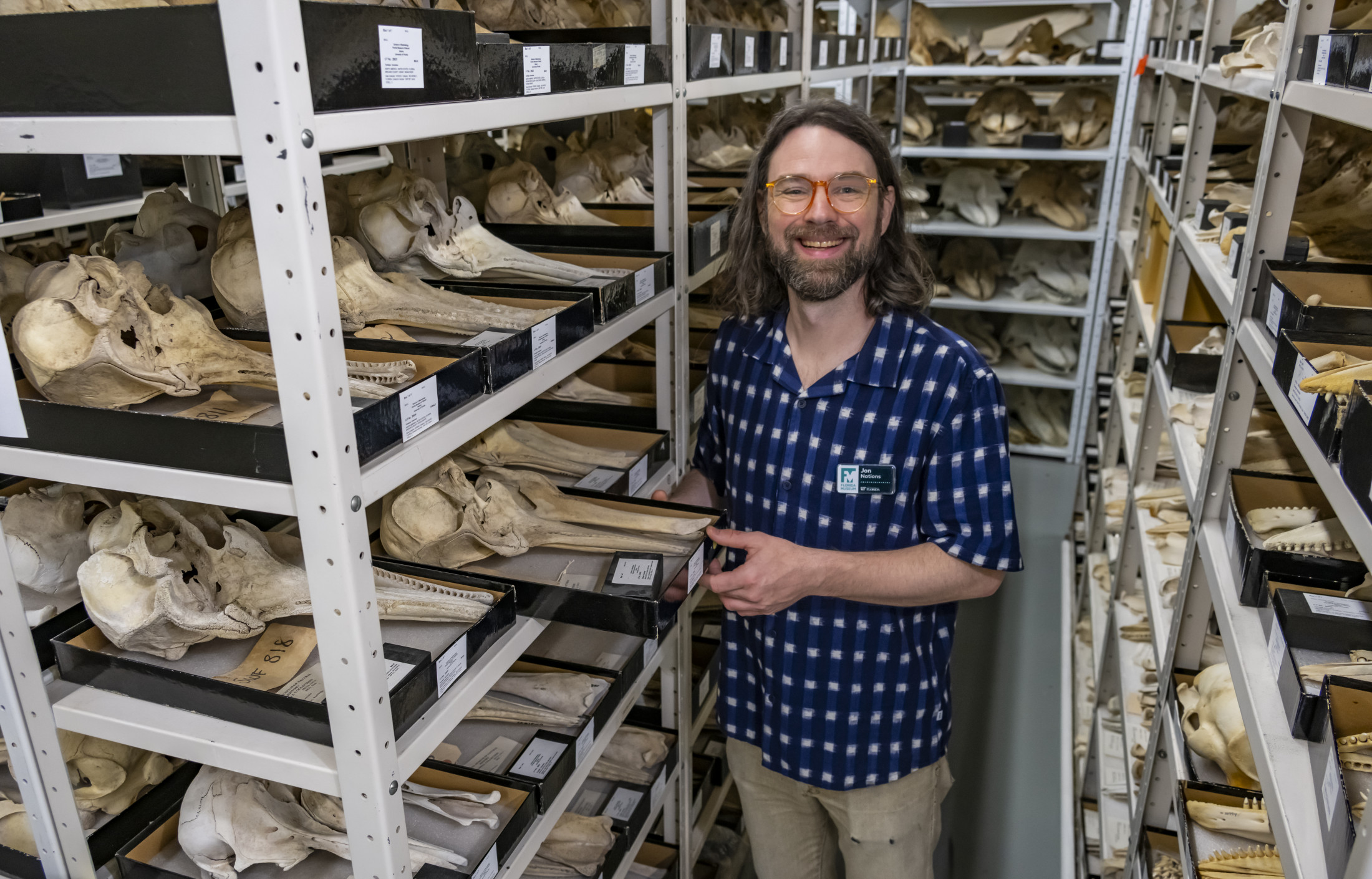Jonathan Nations joined the Florida Museum of Natural History as curator of mammals this April. Before delving into biology, he indulged a growing interest in mammals by working at veterinary clinics in Seattle.
While working toward an associate degree at a local community college, he enrolled in a 1-credit research course on a whim, which changed his trajectory.
“I met some of the teachers who were leading undergraduate research at the community college, one of whom had done his doctorate at the Burke Museum,” Nations said. Together, they embarked on a project that involved surveying small mammal communities in Seattle parks. As part of this effort, he also began working alongside staff at the Burke Museum of Natural History and Culture.
“That was my first exposure to field work with small mammals and my first experience with museums. I haven’t looked back since that point.”
Nations later transferred to the University of Alaska Fairbanks. There, he began working part time at the Museum of the North, where he briefly held the record for preparing more marmot specimens than anyone living or dead. The title was soon wrested back by the resident collection manager, but the experience gave Nations firsthand knowledge of how museum specimens are collected, prepared and curated. It also sparked an interest in how mammals are put together: the way their muscles and tendons attach to bone and how that architecture translates into movement.

Florida Museum photo by Jeff Gage
Nation’s fascination with the relationship between form and function was piqued when the museum’s curator of mammals mentioned an odd discovery he’d recently made. He’d been placing no-kill mammal traps in trees to attract flying squirrels for his students to observe. But instead of squirrels, he caught northern red-backed voles (Myodes rutilus).
This was surprising. In the entire lexicon of scientific literature, no one had ever mentioned anything about these voles being able to climb. The omission was especially perplexing, given that northern red-back voles are among the most common mammals in the vast boreal regions of North America, yet scientists had somehow missed out on this behavior. These voles also lack the physical features that are most commonly associated with climbing.
“It’s this classic example of animals not doing what they’re supposed to do,” Nations said. He eagerly offered to help get to the bottom of the voles’ enigmatic behavior and was soon setting out bait and camera traps to catch them in the act. He wasn’t disappointed.
“We got video of them eating in the middle of winter, when it’s about 20 degrees below zero out,” he said. “They came out from under the snow, climbed the trees, ate lichen and went back down.”
Nations later accepted a doctoral position at Louisiana State University, where he studied the diversity and evolution of rodents on the islands of Southeast Asia. Compared to their larger and more charismatic relatives, like primates and tigers, the small mammals of the region, such as rodents and shrews, have received little to no scientific attention. This fact was highlighted earlier this year when Nations co-authored a study describing three new shrew species from Indonesia.
“It’s been a reminder of how little we know about mammals,” he said. This might seem counterintuitive, since mammals are often considered a top contender for the animal group that scientists know most about. But, according to Nations, that’s not saying much. “Really, I think we’re just scratching the surface.”
It doesn’t help that Nations studies some of the smallest, most cryptic animals — the ones with an aptitude for flitting through shadows and disappearing down burrows. Few people get to directly observe these nocturnal, secretive creatures in their natural habitat. To understand how they move, what they eat and where they live, scientists have to work backward.
“Almost everything we know, or that we think we know, about small mammals in tropical forests has to be inferred from museum specimens. We have essentially no behavioral information, so in a sense, they’re kind of like fossils, except with exceptional sampling and preservation.”
After finishing his doctorate, Nations completed a postdoctoral research fellowship at the Field Museum and University of Chicago, where he continued his work on small mammal functional diversity on the islands of Southeast Asia. “Weird things happen on islands,” he said. “On the island of Sulawesi in Indonesia, there are 24 different rat species living on a single mountain. That’s the highest number of closely related, terrestrial mammals living in a single area on Earth. This same mountain also houses at least 10 shrew species.”
At the Florida Museum, he intends to continue his work in Southeast Asia and take on some of the small, overlooked mammals in Florida, including a group of shrews whose ranges overlap near the museum. “There’s a putative hybrid zone between two species that has been mapped right through the center of Gainesville. So, on the north side of town, in theory, you would trap a different species than you would in the south. However, this remains to be tested.”
His work may also expand to include larger mammals as well. During his first month on the job, he helped collection manager Verity Mathis prepare and bury an exceptionally large manatee that died of old age in captivity. The remains will be allowed to decompose before the skeleton is cleaned and curated.
He notes, too, that the museum has an exceptional collection of Florida panther skeletons. DNA and morphological data from these specimens could be used to inform conservation efforts and help researchers develop a better understanding of how cats both big and small have evolved over time.
Source: Jonathan Nations, jnations@floridamuseum.ufl.edu
Media contact: Jerald Pinson, jpinson@floridamuseum.ufl.edu, 352-294-0452